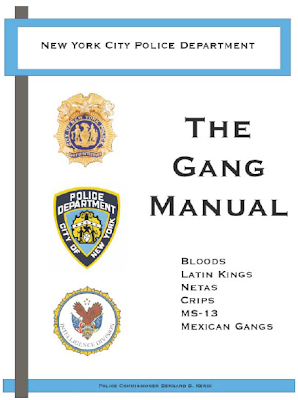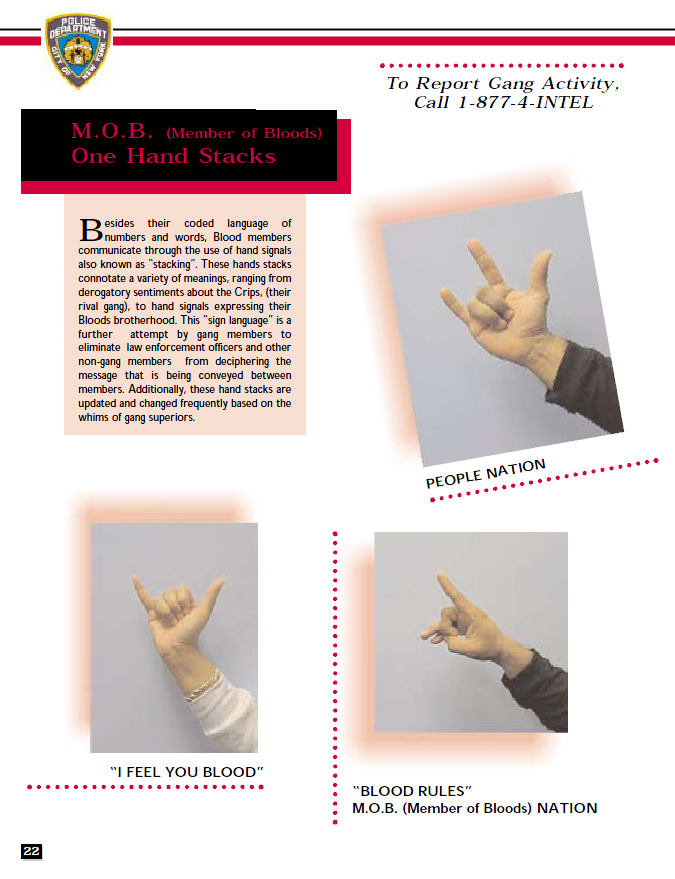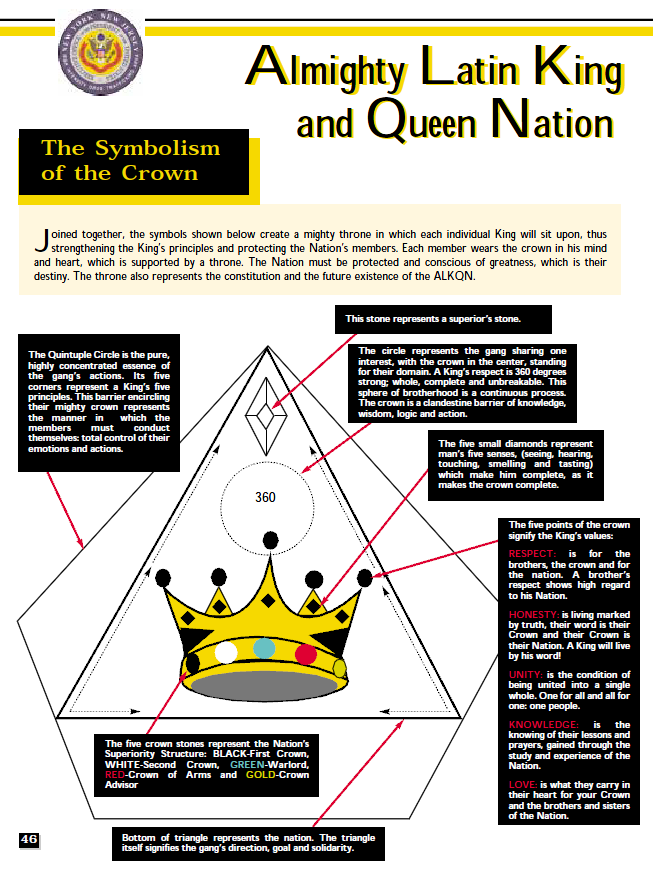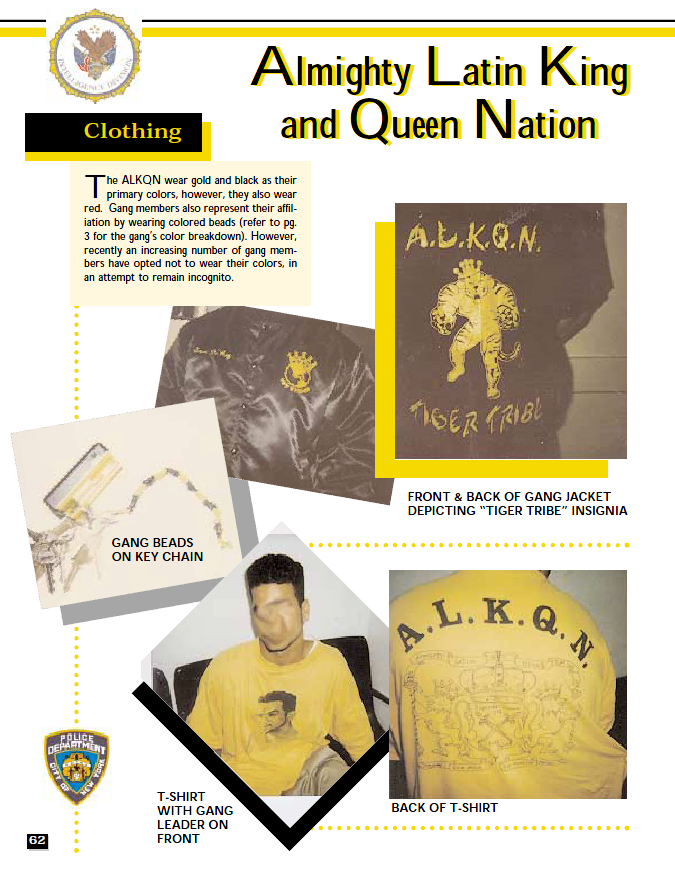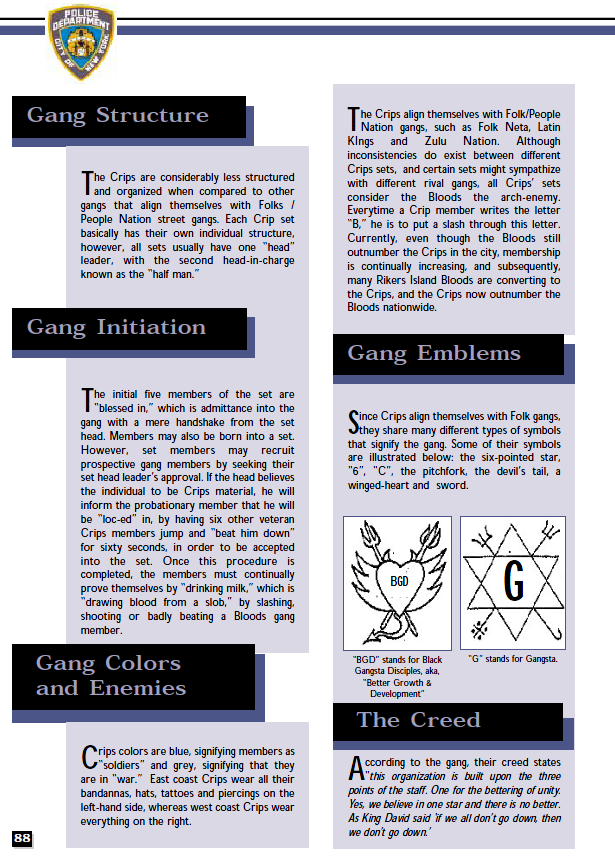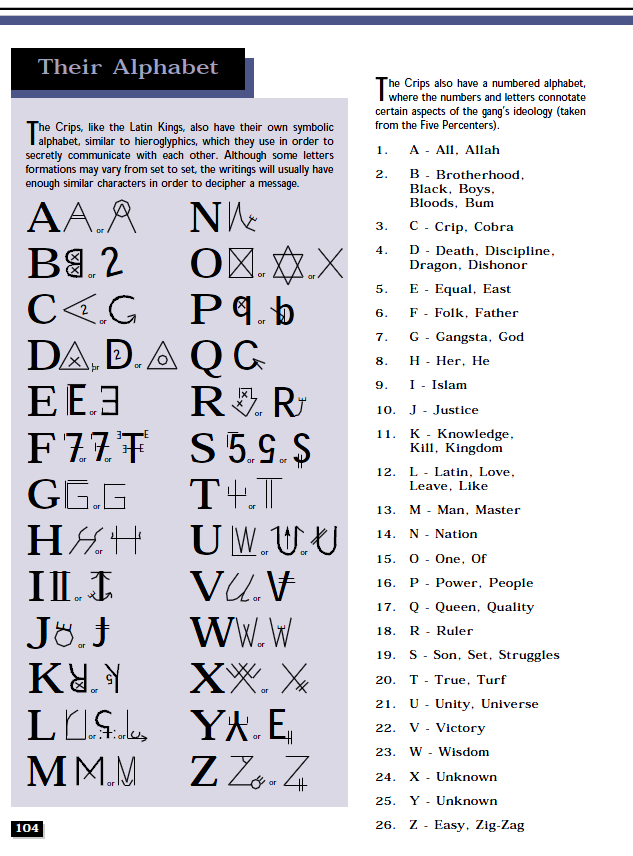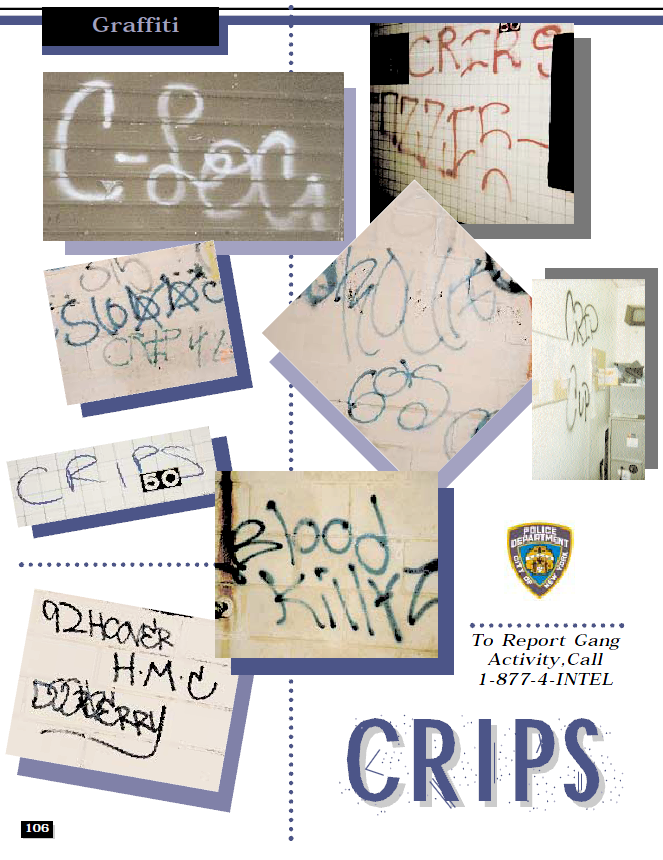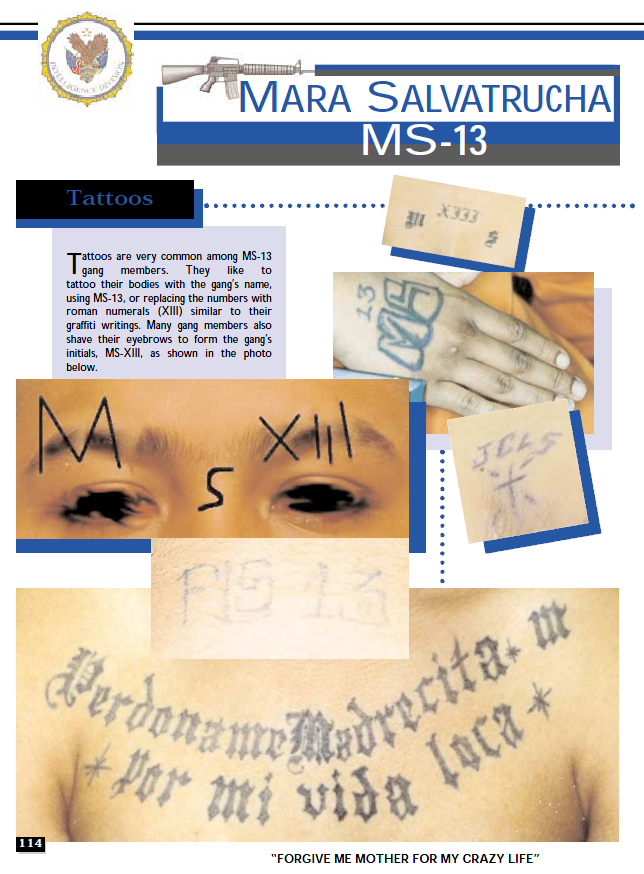 Started in Los Angeles as a street gang in the 1960s, spread to Texas prisons in the 1980s. Besides serving the broader purpose of neighborhood protection, the Bloods street gang originally arose as an opposing force to their rivals the Crips, who had been allying with various other gangs in the 1970s and becoming more powerful. As a result, the Piru gang allied with the Denver Lanes, the LA Brims and the Lueeders Park Hustlers to become the Bloods in 1972. "Bloods" was a term that African-American fighting men called each other in the Vietnam War. The Pirus later changed their name to Bloods.
Started in Los Angeles as a street gang in the 1960s, spread to Texas prisons in the 1980s. Besides serving the broader purpose of neighborhood protection, the Bloods street gang originally arose as an opposing force to their rivals the Crips, who had been allying with various other gangs in the 1970s and becoming more powerful. As a result, the Piru gang allied with the Denver Lanes, the LA Brims and the Lueeders Park Hustlers to become the Bloods in 1972. "Bloods" was a term that African-American fighting men called each other in the Vietnam War. The Pirus later changed their name to Bloods.The East Coast Bloods began in 1993 in New York City. Leonard "Deadeye" MacKenzie, then 26-year-old inmate from Brooklyn living inside a Rikers Island cell, and fellow prisoner O.G. "Original Gangsta" Mack, founded the New York chapter of the United Blood Nation in 1993. Deadeye is now in his late 30s and is incarcerated in upstate New York.
By the late 1990s, New York Latin Kings leader Antonio Fernandez (AKA King Tone) aknowledged that the Bloods have begun to dominate New York's prison system, and that his own gang has abandoned criminal operations in favour of political-activism. Because of this abatement in Latin King crime, the Bloods have a stronger and larger population in jail.
* 59 bounty hunter (Dallas, TX)
* Alberta Warriors, some current hostility reported in Alberta. In 2006 a Warrior member was murdered by a Blood member in the city's Abbottsfield neighbourhood.
* Crazy Dragons, some current hostility reported in Alberta
* Crips.
* Gangster Disciples - reported rivalry in Indianapolis between the GD and the Circle City Neighborhood Bloods (now the Dub Trey Gangsters)
* Latin Kings - reported brawls have broken out between the Bloods and Latin Kings in New York state prisons. New York street rivalry is also especially prevalent. However, as mentioned above, recent events have suggested the Latin Kings have abated criminal operations in New York in favour of political aspirations.
* MS-13 - the Bloods In Long Island have reportedly been in conflicts with MS-13
* Neta Association - there have been reported fights between the Netas and the Bloods in Rikers Island penitentiary.
* Redd Alert, current hostility reported in Alberta
* Sur-13
* Trinitarios
* According to user sources, many Bloods are also rivals with many Asian gangs
Hundreds of factions or sets of the Bloods exist, some of which include:
1. 007 Bonton Bloods (Dallas,Texas)
2. 031 Bloods (Antigua & Barbuda)
3. 21st Treetop Pirus, Northside Fort Worth, Texas
4. 223 East Grand Bloods (Dallas,Texas)
5. 3rd Gate Bloods (Eastside, Fort Worth)
6. 4 Duece Killers (Blood set out of Edmonton)
7. 414 Bloods
8. 415 East Dallas Bloods (Dallas,Texas)
9. 44 Oakland Guerilla Jungle Bloods (South Dallas, Texas)
10. 51-50 Westside Skyline Pirus
11. 54st Mafia (also known as Blood Bangin' Piru, started in San Diego,CA and now covers three major cities, including:Houston,Boston,and Phoenix.
12. 5700 Arlington Park Bloods (northwest Dallas, Texas)
13. 5-9 Brims, in New York City and New Jersey, and Bristol Township
14. 59 Bloods (Shreveport, Louisiana)
15. 7 duece 4 (TRU), Hmong Bloods gang in Fresno, CA
16. 901 Bloods, (Southside Fort Worth)
17. Alley Bishops
18. Almighty Blooded Vice Lords (Vice Lord and Blood Gang connection in Indianapolis)
19. Ardwick Blood Crew, Toronto, Ontario
20. Athens Park Boys (from Avalon Boulevard to Figueroa in L.A.)
21. Baldwin Village Bloods, based in a community in southwest Los Angeles, as of late 1990s.
22. Black Star Nation
23. Block Bishops
24. Black Demon Soldiers, a subset of the Neighborhood Rollin 20s Bloods
25. Bloodstone Villains, reported in Los Angeles.
26. Bo-Gars, Montreal chapter that began in the 1980s.
27. Bounty Hunters (from the Nickerson Garden projects in L.A.)
28. Boyz Sheboygan, Eastern Wisonsin and Sheboygan
29. Brim Bloods (Six Duece Brims/62 Brims)
30. Brownsville Bloods, reported in Brookyln, NY. In 2000 two of the gang's members, Tysheen Bourne and Andre Fields, were shot and killed by police after allegedly trying to mug them.
31. Campanela Park Pirus, Compton
32. Cedar Block Piru - Compton, CA (known for the Rapper "The Game")
33. Chalktown Bloods (Toronto, Ontario)
34. Charlotte, North Carolina, where police say the Bloods make up the largest gang in the city, which holds over 70 gangs, including MS-13, Latin Kings, and Crips.
35. Circle City Neighborhood Bloods (CCNHB) (now called the Dub Trey Gangsters) - with the two c's struck out like a cent sign. CCNHB in Indianapolis are reportedly known to wear red NY Yankee hats, meaning Neighborhood Youngstaz, and Cincinnati Reds hats because of the red "C.". Stop Snitchin t-shirts identify all Bloods in Indianapolis (Dip-Set's brand shirt).
36. Code Red, a Blood-Vicelord faction
37. Concepts of War, a New York City set known among police and the public for its infatuation with violence.
38. Crazy Pyro Bloods? (this may not be correct)
39. Dark Cloud Bloods, in Vancouver, BC
40. Denver Lanes Bloods (from Imperial Highway and Century Boulevard to 109th Street in L.A.)
41. Deuce 8 4 G-Squad Bloods, 284 Goon Squad (Arlington, Texas)
42. Dip-Set - Harlem, New York City (A sub-set of the Nine Trey Gangsters in Harlem), and another Dipset located in Indianapolis.
43. Dog Posse, an early 1990s Denver-based faction reportedly known to retaliate against residents who call police
44. Doubletree Villains
45. Dub-Trey Gangsters - Formerly known as the CCNHB, Rollin 20s, and the 317 Bloods. The name represents the year 2003 when the gangs were started in Indianapolis. They are reportedly rivals with certain Gangster Disciples, but not all, and many Sureno gangs. Dub Trey Gangster Bloods are known to wear Atlanta Braves hats also for the A.
46. East Coast Damus
47. East coast Rollin 30 Limestone Piru
48. East Homicide Brim, NY, Queens
49. Eastwood Pirus (Fort Worth, Texas)
50. Flatlands, an Omaha-based gang reported in the late 1990s.
51. Forest Hill Bounty Hunter Bloods, Forest Hill, Fort Worth,Texas
52. Fox City Bloods, a Hmong gang from Appleton and Green Bay, WI
53. Fox Valley Bloods, a Hmong gang from Appleton and Green Bay, WI
54. Frontstreet Southern Blood (aka the 20 Gang (20th st Southern)) - South Phoenix, Az.
55. Fruit Town Pirus, Compton-area gangs rival to the local Nutty Block Crips
56. Gangsta Miller Bloods, a gang that allegedly operated in and around the Robert Wagner Houses, along First Avenue between 120th and 124th Streets, New York.
57. Go Hard Bloods (GHB) - Jefferson Park, Elizabeth, New Jersey
58. Gun Squad, in the New York City area
59. H.S.B. Hele st. Boyz (Kailua, HI)
60. Harvard Park Brims
61. Highland Courts Bloods - Little Rock, Arkansas
62. Hightowers, reported in the Bronx in 2000, and reported by user sources in Oneco, CT.
63. Homicide Bloods (Roywoods) (Toronto)
64. Immortal Bloods (IB) - 113 set in Wausau, Wisconsin
65. Inglewood Family Bloods
66. Jungles - South Central, LA (Known for the dead end street full of Black P Stone Bloods in the film Training Day)
67. Jungle Posse/City Bloods (Lawrence Hieghts, Toronto, Ontario)
68. Killer Gangster Bloods, a New York City gang that began in Rikers Island, and blamed for local prison violence, for instance in the Schenectady and Albany County jails.
69. King Pin Bloods (Based out of Edmonton, Alberta)
70. Kingsway Bloods - Edmonton, Alberta
71. Laos Bloods, a Laotian gang reported in Milwaukee, WI and Cleveland, OH, (especially, as the mid-1990s, West Technical High School and the West Side of Cleveland between Lorain and Detroit avenues). They are inimical to the Crips and wear the colour red.
72. Laos Boys
73. Lime Hood Bloods
74. Lueders Park
75. L95
76. Midland Heights Blood 304 (Ft.Smith, Arkansas)
77. Mob Town Pirus, in Los Angeles
78. MOD 301 (Menace of Destruction aka Method of Destruction), Hmong Blood gang
79. Nawf Side Gangstaz (aka 5x9 Blood Gang), Terrell, Tx
80. Neighborhood Piru - original Bloodset in Wichita, Kansas
81. Nine Trey Bloods
* A recent police raid on the New Jersey Nine Treys, considered by local media to be the most violent set of the Bloods, netted law enforcement at least 60 gang members and 100 arrests. Officials have claimed the chapter operates in Trenton, Newark; Paterson; Asbury Park; Atlantic City; and the Bridgeton-Millville-Vineland area.
* The Nine Treys were named after the term "1993", the year the gang was formed at New York's Rikers Island jail in an effort to protect its members from other rivals. Its hierarchy is a supposed mix between mafia and military organization, with "original gangsters," five-star generals, captains, lieutenants, and sergeants making up the leadership's "inner cabinet."
* According to user sources, the Nine Trey Bloods set is the biggest on the east coast. They are also found in Virginia.
82. Notty Head Troops (NHT)
83. Ortan Park Bloods (Scarborough, Ontario)
84. Overbrook Bloods, allegedly created in 2002 in Overbrook, a neighbourhood in the eastend of Ottawa, Ontario
85. Red Clover Gangsters
86. Red Dog Piru, reported in New Jersey
87. Retta Mob Gangsta Bloods (St.Louis)
88. Rollin 20s (now called the Dub Trey Gangsters) - a Blood Faction in Indianapolis (not to be confused with LA's R20's set), and is clicked with the CCNHB. However, neither Bloods nor Crips are reported to be very prominent in Indianapolis in comparison with the Folk and People Nation.
89. Pelham Park Bloods (Toronto, Ontario)
90. Pirus, which reportedly stands for "Powerful, Intellectual, Radical, Universal Soldiers"
91. Pueblo Bishops
92. Scott Park Killers, reported in Carson, Los Angeles
93. Sex, Money, Murder, whose alleged leader, Tommy Terrell Thompson, confessed to conspiring to assault and murder his rivals, including ordering the shooting of a wheelchair-bound man he thought cooperated with federal agents in 2003.
94. Sex Money Murder-252
95. South Side Piru - Hope, Arkansas
96. Suicidal Gangster Bloods, Hmong makeup, reported in Twin Cities, MN
97. Tay 57 Bloods, Oriental gang reported in Twin Cities, MN
98. Texas Head Busta Bloods,THB Fort Worth,Texas
99. Toyen Bloods, in Oslo, Norway
100. Trife Kids (Finch area, Toronto, Ontario)
101. True Asian Bloods
102. True Portuguese Bloods (a set based in Toronto's Little Portugal.)
103. Truman Street Bloods - Fort Worth, Texas
104. Tiny Oriental Bloods, reported in Twin Cities, MN
105. Tree Top Piru Bloods
106. Treyside Bloods, in the Bronx, NY, who based the name after the 300 block of Beekman Avenue, where they allegedly operated their drug network. 28 members were indicted in 2005.
107. Trey 17 Blood Gangsters (T17BG). Trey-17 Bloods wear red Texas Ranger hats like the Rollin 20s Bloods of LA.and Indianapolis.
108. True Portuguese Bloods (Toronto, Ontario)
109. United Blood Nation (UBN) - the UBN originated in California in the mid 1980s as a means to consolidate Bloods into one Nation of Bloods. The United Blood Nation spread to New York City prisons in the 1990s (Rikers Island), and have since been reported prominently across the eastern seaboard. These latter Bloods are also referred to as the East Coast Bloods. According to the Gaithersburg Police Department, quoted in the Baltimore Sun (18 March 2005) , East Coast-based UBN members focus on extortion and prostitution, while the L.A.-based Bloods focus on the illegal drug trade. However, the association between the UBN and the Westcoast-Bloods is often confused. Some say the United Blood Nation and the Bloods are not formally connected, and that UBN started without the permission of the westcoast Bloods, operating on its own with its own leaders and identifiers.
110. Uptown Bloods- New Orleans, LA
111. Valentine Bloods
112. Vampire Bloodstone (aka Vampire Bloods, aka Vampires) - operations in New York, New Jersey, Maryland, the East Coast, and several South and Southwestern states. The gangs emerged together basically as the Stones & Vampire Bloods.
113. Van Ness Gangster Bloods
114. Warriors
115. Westside Mob Piru
116. West Side Piru, LA, California, and Oregon
117. Westside Passadena Denver Lanes
118. Willowridge (Rotten Ridge Bloods) (Etobicoke, Ontario)
Most of the primarily Black street gang operates in prisons and on the street across much of California, but they have long since spread to other states. They have approximately 5000 members in Los Angeles alone (where they operate their national headquarters), but have set up chapters in Chicago, New York, New Jersey, Seattle-Tacoma, and Little Rock, Arkansas.
New York's Department of Corrections recently started up a Gang Intelligence Unit that identified the different Blood sets operating in New York prisons and jails, including the Gangsta Killer Bloods, the Sex Money Murder Bloods, the Concepts of War, and the Nine Trey Gangstas. New York's prison system has suffered considerable challenges from Bloods inside state prisons, with many corrections officers saying that the rise of the Bloods have resulted in making themselves feel "targeted" for the first time. According to the Village Voice's coverage, staff often get hurt intervening in conflicts, and have begun getting "popped without warning, with no rational explanation" (21 October 1997 The Village Voice).
In addition to California, signficant numbers and incidents of the Bloods have been reported in the following local, state, and federal prisons:
* Albert C. Wagner Youth Correctional Facility near Bordentown
* Auburn Correctional Facility, NY
* Bayside State Correctional Facility, New Jersey
* Burlington County Detention Center - according to users, where approximately 10-20 Bloods members attempt to control prison tiers, including televisions, telephones, and board games
* Centennial Correctional Facility, Colorado
* Cimarron Correctional Facility, Stillwater, Oklahoma
* Clinton Correctional Facility
* Coxsackie Correctional Facility
* Essex County Jail, MA
* Folsom State Prison
* Franklin Correctional Center, Bunn, North Carolina
* Great Meadow Correctional Facility in Comstock, N.Y
* Hudson County Correctional Facility
* Lansing Correctional Facility, Kansas
* Lehigh County Prison, PA. In New Jersey, as of 1996, they numbered just above 1,000.
* Limon Correctional Institution in Colorado
* Los Padrinos juvenile hall, part of the backdrop of West Side Rollin' 20s Bloods member Terrell Wright's autobiography.
* Morris County jail.
* Northern State Prison, NJ
* Northampton County Prison in Easton Pennsylvania
* Mercer County jail, New Jersey
* New Jersey State Prison (Trenton)
* Passaic County Jail, NJ
* Pelican Bay State Prison
* Rikers's Adolescent Reception and Detention Center
* San Quentin State Prison
* Southport Correctional Facility near Elmira, NY
* Sullivan Correctional Facility
* Suffolk County jail in Riverhead, NY
* Sing Sing
* Willard Correctional Facility, in Seneca County, NY
* Wyoming County Correctional Facility
The Bloods street gang is reported to have or have had in the past headquarters at:
* Allentown, Pennsylvannia
* Avon and Lyons avenues and Aldine Street in Newark, NJ
* California (multiple locations)
* Columbus, Ohio.
* Jersey City, NJ
* Essex County, NJ, supposedly one of the Nine Trey Bloods' most powerful stronghold
* Florida (multiple locations)
* Kansas City, Mo
* Miami, Florida
* New York (multiple locations)
* Shreveport, Louisiana
* Seattle-Tacoma, Washington
* Suffolk County, NY
* Trenton, NJ (Sex Money Murder)
Previous East Coast Bloods have or have had headquarters on 183rd Street and Davidson Avenue in New York City. They have chapters at Norfolk, Virginia, Harford County, Maryland, Albany, NY, Los Angeles, CA, New York City, Portland, Oregon. For a more detailed list of Blood sets and their locations, refer to the factions section above.
Because it has no written constitution, the Bloods are officially labeled a "security threat group" in prison, not a street gang per se. The gang deals in murder, conspiracy, credit card fraud, extortion, prostitution, and drug trafficking. Despite the stigma of violence, founding Blood member Omar Portee started the gang for the purpose of "brothers getting together, people getting together, fighting oppression" and not to advocate violence and killing.
According to news reports, the following members have (or have had) alleged executive connections:
* Omar Portee, aka OG Mack" or "The Big Homie", was alleged leader of the Rikers Island prison gang called the Universal Blood Nation, which then became the East Coast chapter of the Bloods street gang. He was sentenced in 2003 to 50 years in prison for murder conspiracy, credit card fraud and drug selling
* Oscar Izquierdo,Grand Master OG, who helped form the BLACK P. Stones, and founded the Egyptian Kings & Vampires. He is around 80yrs old and is reportedly alive, in retirement.
* Lemrey Andrews, alleged lieutenant
* Eric Nikwan Barnett, alleged leader of the Harford County, Maryland Bloods
* Shaidon Blake, reputed high-ranking of the Bloods in Los Angeles
* David "Duke" Allen, reported head leader of the Newark, NJ chapter, was recently the focus of a 500-strong police raid from local, state, and federal law enforcement agencies, which secured over 100 arrests. He was apparently operating as "godfather" from within Trenton State Prison in New Jersey.
* Sherman Adams (A.K.A "Sherm Da Worm"), Queens native and leader of the Rikers Island Blood Set in the 1990s, serving two life sentences. Dubbed the "Superior of All Adolescents" as a teen, based on his penchant for slicing rivals with a razor, Adams gained local notoriety in New York by broadcasting the message that the Bloods activities were aimed at representing the interests of African American inmates in jail. As a result of his flair for blade-weilding, he was assigned the corrections department's highest security rating, Code 2. Correctional officials literally treated him with kid-gloves, covering his hands with black mitts when he left his cell for visitors or for court appearances. In 1997, he was the highest ranking Blood member inside Rikers's Adolescent Reception and Detention Center.
* Tommy Terrell Thompson, leader of the Jersey City, NJ chapter
* Terrance A. Smith, reported Baltimore chapter leader
* Lakya McLean, alleged "Queen" of the Albany Bloods
* Shawn Decambre, alleged leader of the Allentown chapter of the street gang
* Paulette McCartha, alleged leader of the female "Bloodettes"
* Jamie "Dino" Reardon, alleged leader of a New Jersey chapter, arrested in 2002
* Dwayne "Poochie" Parker, alleged leader of the Tacoma, WA chapter
* Dupree "Turf" Harris, alleged leader of a Brooklyn, NY chapter
* Eric James, alleged leader of a Colorado street gang chapter in 2003
* Tony Rodgers, alleged former leader who as of 1994 runs a consulting firm known as Sidewalk University in Los Angeles
* Gary Guest, suspected leader/organizer of a New York Bloods drug operation
* Gregory Bush, alleged former leader of an Omaha chapter of the Bloods (deceased)
* Christopher Witcher, an alleged leader of a Washington-area chapter of the Bloods
* Sam Quintana, reported former leader of a Denver-based street gang chapter
* extending the index and little finger while folding the middle second and third fingers over one another is a sign that you are a member of the Brim set of the Bloods
* forming a circle with the index and thumb with middle, ring, and pinky fingers straight.
* On the left hand extend the index & pinky fingers and fold in the middle finger, ring finger inside the folded thumb & on the other hand extend the index, ring, & pinky while making a circle with middle finger & thumb then cross your wrists, right hand on the outside left to the inside is showing that you are a member of the Dub Trey Gangsters in Indianapolis.
* Anaheim Angels hats are worn by members of the Dub Trey Gangster Bloods of Indianapolis for the A meaning ''anywhere" in the city.
* Atlanta Braves caps - Dub Trey Gangsters
* East Coast Bloods wear Boston Red Sox caps because of the red B
* Miami Heat jerseys identify Miami East Coast Damus.
* Pitbull, which has been reported to identify the Bloods near Mont Claire and Adams in Los Angeles.
* RXXS, identifying the Rollin 20s, where the two Xs represent the sum of 20 in roman numerals.
* Seattle Mariner's cap - West Side Rollin Sixities wear the Seattle Mariner's cap, called an "S" Hat
* Starter jackets and Chicago Bulls jerseys
* St. Louis Cardinals hats are worn by Black P. Stones Bloods in Los Angeles, meaning ST.one L.ove.
* Texas Rangers baseball caps (West Side Rollin' 20s NeighborHood Blood)
* Crossed out sixes on the right arm.
* "MOB" for Money over Bitches
* DOG TATTOO'S
* THE WORD DAWG
* Scars on the right shoulder normally burned by cigarettes or cigars in the shape of a dog paw.
* "000" - means OG
* "031" - love/solidarity/number code for blood
* 211 - Crip Killer
* "212" Blood code - 'let me holla at you.'
* "5 poppin 6 droppin" - Bloods are shooting and Crips are dying
* "B-one-eight-seven" means homicide, or the act of killing a rival member, such as the Crips, reflecting the police code for homicide, 187.
* "B Unit" - Blood Unit
* "Bang'Em" - Kill A Crip
* "BCC"
* "bomedy" - comedy
* B L O O D- Blood Love Overcomes Our Depression
* B.R.A.A.T. - Bloods rule all around town
* "Bro" means Blood (way of seeing if there's a blood in jail)
* "Bool" - cool
* "Boompady Bop"- Phrase said by a Blood to disrespect a Crip
* "BPB" - Bragging Pretty Bitches
* "Dipset" - blood faction
* "Bunny Hunters" - Bounty Hunters
* "burners" mean guns
* "C.K." means "Crip killer"
* C.R.A.B.- Crips Really Are Bloods
* "Ike" - dude
* "Rips" refers to Crips
* "B-rabs" refers to Crips insult - "Brabs" means Crabs, what Bloods call Crips but since they cannot pronounce the C they use a B.
* "Erickets" refers to Crips insult
* "Denver Lames" refer (derogatorily) to the Denver Lane Bloods
* "GS"- Gay soldier, said by a Blood to disrespect a Crip
* Hard Backs- derogative terms for Crips
* jungles - ghetto areas belonging to Bloods
* "MOB" means money over bitches and member of bloods
* OG - Original Gangster
* OTM - "Out That Mob"
* Red DoggTags - Identifies EastCoast Bloods
* Rice Crispies refers to the Raymond Ave Crips
* Nappy Heads for the Neighborhood Crips
* "One Eight Trey" - East Coast Bloods
* Paisley - design used by Bloods on bandannas
* "pu55y" - variation of pussy
* "Swayhooks" - Swans
* "Sissies" - perjorative term for Rollin Sixties
* "Tramps" - Eight Tray Gangster
* "Peter Rolled" is a Bloods term for murder
* "Blooded in" means admitted as a full member
* "What dat B like homeboy!"
* "What It B-Like"
* "What's Poppin" - "What's up/happening"
* "What's Brakin"
